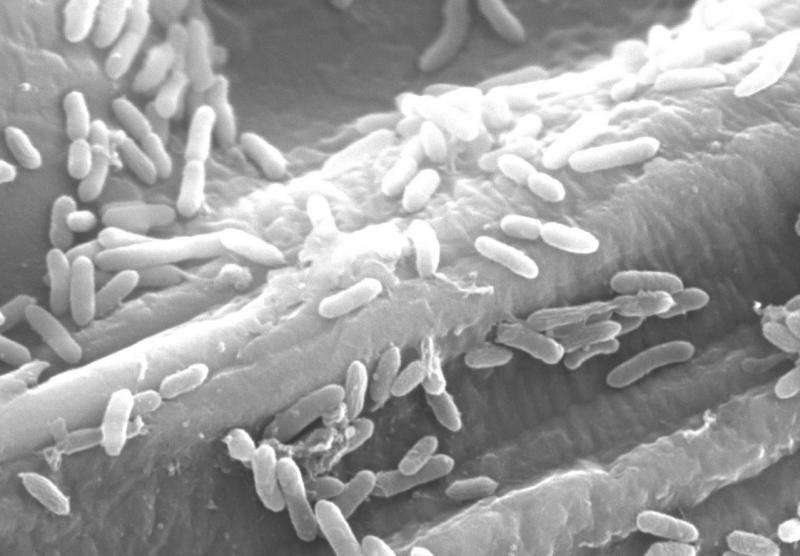Detection of fermentation processes in electricity-generating bacteria

A research team consisting of Akihiro Okamoto (Senior Researcher, Center for Green Research on Energy and Environmental Materials, NIMS), Yoshihide Tokunou (Ph.D. student, Department of Applied Chemistry, Graduate School of Engineering, University of Tokyo; also a recipient of the JSPS Research Fellowship for Young Scientists (DC1)) and Professor Kazuhito Hashimoto (NIMS President, formerly affiliated with the Department of Applied Chemistry, Graduate School of Engineering, University of Tokyo) discovered that "electricity-generating bacteria" used in microbial fuel cells undergo fermentation while producing electricity, which is contrary to the conventional belief that the bacteria only carry out respiration when producing an electric current. The team also identified a mechanism whereby the fermentation process accelerates. Because the fermentation process has greater potential than the respiration process in terms of the bacteria's contribution to the production of diverse materials, increasing the fermentation efficiency of the bacteria may lead to the development of a novel technology applicable to not only electricity generation but also material production.
Bacteria generally obtain life-sustaining energy by breaking down organic material through two types of metabolic processes: respiration and fermentation. Electrons are generated when they break down organic material (reducing power). When bacteria respire, they gain energy by transferring electrons to extracellular electron-accepting substances. During fermentation, extracellular electron transfer does not occur. In microbial fuel cells, electricity-generating bacteria are capable of transferring electrons generated from the decomposition of organic materials to an extracellular electrode. As such, they can serve as sources of electricity. It had been believed that these bacteria produce electricity only via respiration and do not carry out fermentation. Both bacterial respiration and fermentation have a wide range of industrial applications. Specifically, fermentation enables the production of a diverse array of materials, such as alcohols, pharmaceutical precursors and bioplastics. If electricity-generating bacteria carry out fermentation, it may be possible to develop new technology that will enable the simultaneous production of both materials and electricity.
The research team recently found that the electricity-generating bacterium Shewanella oneidensis undergoes fermentation reactions when producing electricity. In this study, the team prepared cultures of S. oneidensis which lacked the enzymes involved in respiration and another set of S. oneidensis cultures which lacked the enzymes involved in fermentation. The team then analyzed the electricity production and growth rates of the two cultures. The absence of the enzymes required for fermentation was found to be associated with dramatic reductions in both the amount of electric current produced and the growth rate, while the absence of the enzymes required for respiration had no effect on either. In previous studies, detection of extracellular electron transport in S. oneidensis was assumed to be attributable to a respiratory process. However, this study demonstrated the presence of intracellular fermentation reactions, indicating the existence of "fermentation-like respiration." It was also found that the rate of the fermentation reactions likely increase by enhancing the proton (positively charged hydrogen ion) transport rate, as protons limit the rate of electron transport. Using this mechanism, it may be feasible to increase the efficiency of fermentation reactions occurring on electrode surfaces in microbial fuel cells.
This research detected a new type of metabolic process taking place in electricity-generating bacteria. In future studies, the research team will seek to understand the mechanism controlling the proton transfer rate, increase the efficiency of the fermentation reaction using that knowledge and develop technology that will allow the efficient production of materials. In addition, it is possible to convert Escherichia coli―a model microbe for the study of biosynthesis―into an electricity-generating bacterium through genetic engineering, and the rates of its various metabolic processes, which are the focus of various R&D efforts, likely raise by increasing the proton transport rate.
More information: Akihiro Okamoto et al. Proton Transport in the Outer-Membrane Flavocytochrome Complex Limits the Rate of Extracellular Electron Transport, Angewandte Chemie International Edition (2017). DOI: 10.1002/anie.201704241
Journal information: Angewandte Chemie International Edition
Provided by National Institute for Materials Science




















